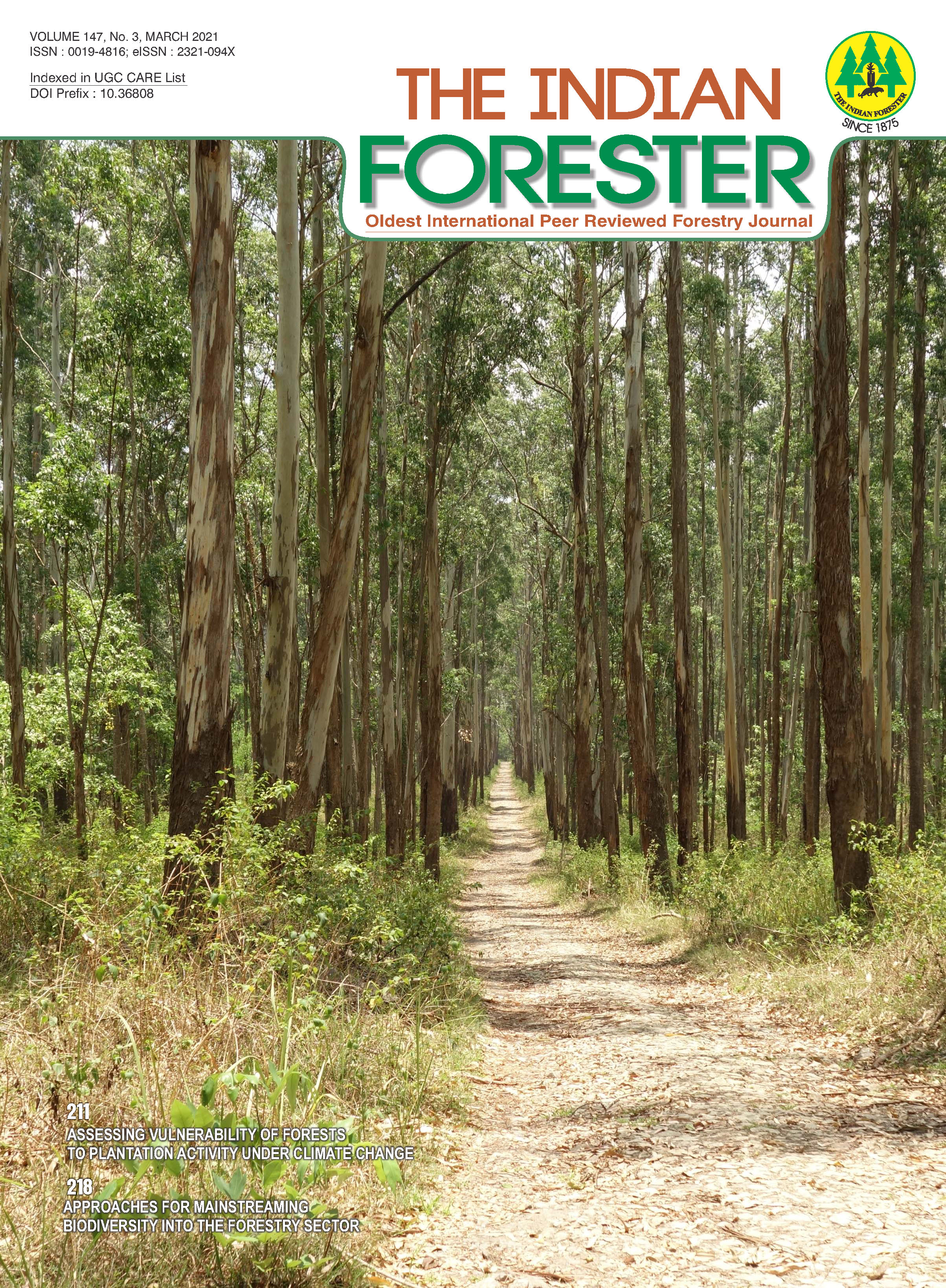Assessing Vulnerability of Forests to Plantation Activity under Climate Change
DOI:
https://doi.org/10.36808/if/2021/v147i3/152105Keywords:
Assessment, Climate Change, Indicators, Plantation, Vulnerability.Abstract
Plantation activity is often employed to restore, enhance or conserve forests and biodiversity. However, an inadequately designed plantation activity can potentially exacerbate the vulnerability of a host forest ecosystem. This study presents an indicator-based methodological tool to pre-assess the likely augmentation of vulnerability of a forest system due to plantation activity under climate change. Indicators representing genetics and mix of species, intensity of site preparation, planting density, status of forest fragmentation, and support of proximate communities are selected for the assessment. A vulnerability index of plantation activity (IPA) is developed to present the results. Prior assessment enables calibration of plantation activity for reducing the vulnerability. The methodological tool is easy-to-apply and universal in application.References
Boulter, S. (2012). A preliminary assessment of the vulnerability of Australian forests to the impacts of climate change – Synthesis. National Climate change Adaptation Research Facility, Gold Coast. 254pp.
Brockerhoff, E.G., Jactel, H., Parrotta, J.A. et al. (2008). Plantation forests and biodiversity: oxymoron or opportunity? Biodiversity Conservation 17:925-951. DOI 10.1007/s10531-008-9380-x
Day, J.K. and Perez, D.M. (2013). Reducing uncertainty and risk through forest management planning in British
Dudley, N. (1998). Forests and climate change. Report. World Wildlife Fund International, Gland, Switzerland.
FAO (2013). Climate change guidelines for forest managers. FAO Forestry Paper No. 172. Rome.
Guariguata, M.R., Cornelius, J.P., Locatelli, B. et al. (2008). Mitigation needs adaptation: Tropical forestry and climate change. Mitigation and Adaptation Strategies for Global Change 13:793-808.
Haila, Y. (1994). Preserving ecological diversity in boreal forests: Ecological background, research, and management. Ann. Zool. Fennici 31, 203-217.
Hartley, M. J. (2002). Rationale and methods for conserving biodiversity in plantation forests. Forest Ecology and Management 155, 81-95.
Köhl, M., Hildebrandt, R., Olschofksy, K. et al. (2010). Combating the effects of climate change on forests by mitigation strategies. Carbon Balance and Management 5:8. doi:10.1186/1750-0680-5-8.
Jactel, H., Brockerhoff, E. and Duelli, P. (2005). A test of the biodiversity-stability theory: meta-analysis of tree species diversity effects on insect pest infestations, and examination of responsible factors. In: Scherer- Lorenzen M, Körner Ch, Schulze E-D (eds) Forest diversity and Function: Temperate and Boreal Systems. Ecological Studies vol. 176. Springer-Verlag, Berlin, pp 235–262.
Kelty, M.J. (2006). The role of species mixtures in plantation forestry. Forest Ecology and Management 233:195–204 .
Payn, T., Jean-Michel C., Freer-Smith P. et al. (2015). Changes in planted forests and future global implications. Forest Ecology and Management 352:52-67
Ravindranath, N.H., Murthy, I.K., Joshi, P. et al. (2014): Forest area estimation and reporting: implications for conservation, management and REDD+. Current Science: 106(9); 1201-14.
Robledo, C., Clot, N., Hammill, A. et al. (2012). The role of forest ecosystems in community-based coping strategies to climate hazards: Three examples from rural areas in Africa. Forest Policy and Economics 24:20-28.
Singh, M.P., Bhojvaid, P. P., de Jong, W. et al. (2014). Forest transition and socioeconomic development in India and their implications for forest transition theory. Forest Policy and Economics. http://dx.doi.org/10.1016/j.forpol.2015.10.013
South, D.B. (1999). How can we feign sustainability with an increasing population? New Forest 17:193-212.
Thompson, I., Mackey, B., McNulty, S. et al. (2009). Forest Resilience, Biodiversity, and Climate Change. A synthesis of the biodiversity/resilience/stability relationship in forest ecosystems. Secretariat of the Convention on Biological Diversity, Montreal. Technical Series no. 43, 67 pages.
Thompson, I. (2011). Biodiversity, ecosystem thresholds, resilience and forest degradation. Unasylva 238 (62) 25-30.
Downloads
Downloads
Published
How to Cite
Issue
Section
License
Unless otherwise stated, copyright or similar rights in all materials presented on the site, including graphical images, are owned by Indian Forester.





